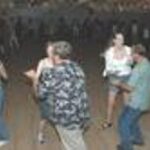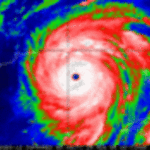A jazz waltz, in jazzspeak, is any piece in triple meter, commonly written in 3/4 time. Like classical waltzes, some jazz waltzes originated as dance music and others as stylized concert music. Waltz style had its greatest impact on jazz history from the early 1900s to the 1960s.
Before the mid-1950s, most jazz music was in duple meter. However, triple meter, though seldom used, played several historically important roles.
In fact, the early history of jazz in New Orleans included much waltz music. According to the great jazz pianist Jelly Roll Morton, New Orleans string bands in the early 1900s regularly played jazz versions of popular dances, such as schottisches, quadrilles, and waltzes.
Waltz-oriented string bands also developed in other jazz communities throughout America. The bands consisted of guitars, mandolins, double basses, and other string instruments. Another popular jazz ensemble in the early 1900s was the jug band, centering on a jug played as a bass instrument and including other available instruments.
Early New Orleans bands did not have opportunities to record their waltz performances. However, string and jug bands elsewhere did leave waltz recordings. Examples include “Missouri Waltz” by Dan and Harvey’s Jazz Band (1918, Columbia 738) and “Jug Band Waltz / Mississippi Waltz” by the Memphis Jug Band (1928, Victor 38537).
During those early years, according to The New Grove Dictionary of Jazz, waltz styles differed between urban and rural areas. Urban jazz fans had access to a steady diet of hot two-beat and four-beat music. Therefore, when they danced the waltz, they wanted a contrast, a smooth, moderate music with fairly predictable three-beat measures.
Rural jazz dancers, however, preferred hot, swinging waltzes. Later, urban audiences, too, adopted the hot variety.
During the swing era of the 1930s-40s, people used the jazz waltz less as a dance form and more as a compositional form. The big-band, sophisticated-arrangement approach to jazz produced a new type of musically enriched waltz.
The most notable swing-era waltz was Fats Waller’s “The Jitterbug Waltz” (1942, Bluebird 11518). He composed the waltz for his own instrument, the piano, but recorded it in a big-band arrangement under his own leadership. The piece, which soon became a jazz standard, shows Waller using the waltz format to explore new rhythmic grounds, but he died before he could take his experiments further.
Triple meter finally became firmly established in common jazz usage with the rise of the “bop waltz” in the 1950s. Bop, short for bebop or rebop (syllables that imitate a staccato two-tone motive distinctive in this music), is a more melodically, harmonically, and rhythmically complex version of earlier jazz. Originating in the mid-1940s, bop supplanted swing as the major movement in jazz and also returned to the use of smaller ensembles.
Thelonious Monk created one of the earliest bop waltzes with his performance as pianist and group leader on the recording “Carolina Moon” (1952, Blue Note 1603). He dramatically altered this simple standard tune into a complex, idiosyncratic version of waltz music.
Another important bop waltz was saxophonist Sonny Rollins’s composition “Valse Hot.” He led a group in a performance of the waltz as a track on his album Sonny Rollins Plus 4 (1956, Prestige 7038). “Valse Hot” influenced many other bop musicians.
In the late 1950s, waltz style helped propel yet another major development in jazz history: modal jazz. The style is based on the use of a harmonic rhythm that is significantly slower than the traditional chord-per-beat or chord-per-measure harmonic rhythm characteristic of earlier jazz (and most other Western music, popular and classical). In fact, sometimes the harmony consists only of an oscillation between two chords or of a drone on a single chord.
The term modal jazz refers to the fact that musicians performing this style often draw on medieval modes as material for melodic and harmonic effects. A common example is the dorian mode, a scale playable on the white keys of the piano from any D to the D an octave higher.
One of the landmarks in modal jazz is saxophonist John Coltrane’s stunning version of the Richard Rodgers waltz tune “My Favorite Things” (from the musical The Sound of Music). The piece is the title track on Coltrane’s album My Favorite Things (1960, Atlantic 1361). While the accompaniment anchors the music with ostinato dorian modal patterns, Coltrane improvises independently, extending the waltz into a prolonged, hypnotic, Eastern-tinged dance.
After bop waltzes and modal-jazz waltzes proved the artistic possibilities of triple meter, many jazz musicians began using the waltz format in a variety of styles. The 1950s and 1960s saw an explosion in important jazz waltzes.
One of the greatest composers of such works was the pianist Bill Evans. His fresh, elaborately chromatic but solidly tonal harmonic idiom and introspective lyricism influenced countless musicians.
Evans put much of his best work into waltz form, notably his own “Waltz for Debby,” originally recorded for his album New Jazz Conceptions (1956, Riverside 223), and his improvisations on the Disney song (from the film Snow White and the Seven Dwarfs) “Some Day My Prince Will Come,” issued on Evans’s album Portrait in Jazz (1959, Riverside 1162). His other waltz compositions include “Waltz in E-flat” (1966), “G Waltz” (1967), and “B Minor Waltz” (1977).
Some jazz artists devoted entire albums to waltzes. The drummer Max Roach led a group in recording Jazz in 3/4 Time (1957, EmArcy 36108), including some of his own waltz music as well as “Valse Hot” by Sonny Rollins, one of Roach’s performers. The trumpeter Shorty Rogers, also as leader of a group, recorded Jazz Waltz (1962, Reprise 96060), featuring several of his own melodies, such as the title track.
Another well-known jazz waltz of the 1960s was “Bluesette” by Toots Thielemans on his album Toots Thielemans (1961-62, ABC-Paramount 482), with the composer performing as both a guitarist and a whistler. The great saxophonist Wayne Shorter wrote the mellow jazz waltz “Wild Flowers” and recorded it with a group for his album Speak No Evil (1964, Blue Note 84194); “Wild Flowers” has become a jazz standard.
Principal source: Barry Kernfeld, ed. The New Grove Dictionary of Jazz. 2d ed. London: Macmillan, 2002.
(Readers are invited to (1) use the comment box below to share the titles of their own favorite jazz waltzes, and (2) listen to the writer’s Bill Evans-influenced “Three-Quarter Jazz” at http://www.sibeliusmusic.com/cgi-bin/show_score.pl?scoreid=106308)




